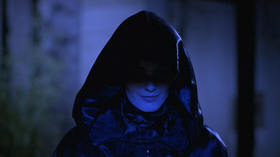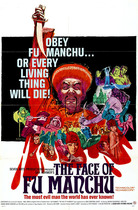Our editor-in-chief Nate Yapp is proud to have contributed to the new book Hidden Horror: A Celebration of 101 Underrated and Overlooked Fright Flicks, edited by Aaron Christensen. Another contributors include Anthony Timpone, B.J. Colangelo, Dave Alexander, Classic-Horror.com's own Robert C. Ring and John W. Bowen. Pick up a copy today from Amazon.com!
The Fruit Cellar: "All My Power… All My Beauty… All My Life"
It's a traditional criticism of the modern horror film that the world represented is sexist in nature. It's a simplistic argument, but one that a surface-level analysis of most horror films would confirm. After all, don't most depict women in peril -- from Halloween to The Texas Chain Saw Massacre to Suspiria? While it might seem like the most obvious of possible assessments, what this criticism fails to recognize are the areas in which the horror genre upends conventional depictions of women as victims.
Unlike the many horror films wherein power must be taken from a male aggressor, the lesbian vampire tale traditionally places all power in female hands, creating a world wherein patriarchy is no longer a sustainable state. In these tales, women are themselves the aggressors. They use their power to take lives and take control -- creating a world in which men become secondary to women. It's nothing if not a corrupted version of matriarchy. Lemora: A Child's Tale of the Supernatural is a film wherein this power structure is clearly defined -- if only briefly criticized.
Lila Lee's father is a gangster who's murdered his wife and her lover. When Lila, now living with a single reverend, receives word from the mysterious Lemora that her father has taken ill and seeks her forgiveness, she leaves the Reverend and heads to the town of Astaroth. Along the way, Lila encounters all kinds of sin and depravity before boarding a bus headed to Astaroth.
When the bus driver is pulled away from the bus by what appear to be monsters, Lila is forced to drive the bus herself. She promptly crashes into a tree knocking herself unconscious. She awakens in a stone shed with a beautiful but ominous mansion in the distance. When an old crone comes to the door with food, Lila knocks her over and makes her escape only to end up in the mansion with Lemora.
Lemora takes on the role of caregiver to the lovely Lila, and it all seems rather benign -- much more so than the myriad of men who have intimated sexual interest -- up to a point. She bathes Lila and gives her clothing. It appears very motherly. But then Lila begins to uncover secrets. She discovers the journal of another young girl who fell into Lemora's clutches. Lemora tells her of a secret ceremony they'll participate in, in which Lemora and Lila will become blood sisters.
When Lila finally sees Lemora feeding off the neck of a young child, all the pieces fall into place, and she naturally flees, taking refuge in whatever dark corner she can find. As can be expected, the chase leads her straight back to Lemora, and she is confronted first with her father and then with Lemora. She fights her father to the death, and weeping over his corpse, Lemora offers her comfort in her eternal embrace.
The film appears to be open to both pro-feminist and anti-feminist readings. Lemora is clearly evil; however, it's difficult to ignore the very complete world the film creates, a world wherein men are always secondary to women. While it is true that power lies in each female character, they wield their power to only negative and exclusionary ends. They subjugate their male counterparts, and as such, it is difficult to see outside the very misandrist frame of the film.
It is in this powerless representation of men that the film is clearest in expressing its allegiance with female power. The men in the film fall into three categories. First come the cads. While Lila makes her journey to Astaroth, she encounters a bevy of men who want to turn the young girl into a sexual partner. In this characterization and the implied battle with Lila's goodness, the film renders these men so one-dimensional (intentionally, it seems) that any role greater than this becomes impossible. They cannot wield power when they themselves are controlled by their baser instincts. This criticism extends to Lila's one hope -- the Reverend -- in a later scene wherein he weakens before temptation.
Shortly after Lila's bus accident, we're given our first view of men working within in the confines of Lemora's power structure. She has a bevy of vampire footmen who do all her dirty deeds. They collect Lila from the car accident and generally do her bidding. It's a sad state for a child of the night. They have the traditional vampire appearance, but all comparisons to their Draculian counterparts end there. There is no romance in their gazes. There is no mystery to them. They simply exist to serve their vampire queen Lemora. As such, they are also rendered somewhat harmless. When a vampire's role is to simply carry out orders, they lose their ability to individually frighten. Lemora's pulling the strings, and these men would never act outside of her commands, and they are, therefore, made useless.
The remaining men in the film are those who've been turned (presumably by Lemora) and have become something other than your traditional vampire. They're monsters from a different decade. They could have stepped right out of a colorized version of a Universal movie, and they are ruthless, violent, and (almost) without reason.
They are also among the most complex figures in this sordid fairy tale. As former victims of Lemora, it would be expected they'd turn into simple vampire slaves to their queen. But instead, they've morphed into aberrations of the already corrupt power of the vampire. Gone is the lonely romantic vampire, the noble aristocratic vampire. While the film gives no definitive explanation for their defects, it should be noted that Lemora herself refers to this situation as an epidemic or sickness, and she engages in a full-on war against them. She must fight them to retain her power, and she uses the rest of her minions to do so -- eventually winning this battle with the unintentional help of Lila. The resultant argument of the battle is that with the combined power of only two females, a battle can be fought and won against any number of male adversaries, and the existing power structure of Astaroth can be maintained.
Most important to note, however, is the notion that destroying the males is a necessity in order to maintain female power. The monster men of Astaroth look to be maleness at its most basic, and it is the strongest threat against Lemora's reign. In order to retain her control over Astaroth and its denizens, she must destroy them, but she is unable to do this on her own. Until the arrival of young Lila, they remain a scourge. It is when Lila first fights one of them (her father) that Lemora is resurrected and able to then turn Lila, who herself becomes a powerful tool for the control and destruction of men -- beginning with the Reverend.
While it is true that the film clearly allies itself with the notion of matriarchy, the film contains within its discussion of feminine power, a criticism of that potential matriarchy. The world as Lemora makes it is no better than the world of men (everything outside Astaroth). When Lila travels through the neighboring villages, she encounters all displays of patriarchy at work. She sees men urinating in the street. She sees men abusing women. She sees women relegated to the status of male-satisfying object. This is the world of the patriarchy. Lemora's offer of matriarchal power, then, must be difficult to resist. After all, Lemora offers an eternity of beauty and control -- something Lila could never have or keep in the real world.
In congruence, Lemora's world is really no different. While there may be order in Astaroth, it is still a world in which supremacy is held by a single individual. While it may be less overtly sexual, there is, of course, a tone of homoeroticism in Lila's shared moments with Lemora. There is no purity in either world, and as such, perhaps the question is no longer one of matriarchy over patriarchy.
The film ultimately has no allegiances. Whether this was intentional or not, it presents two very different worlds --each one complete with flaws. Perhaps it should be read as a downbeat ending. While there is a clear winner of the final battle, the film seems to suggest, however unintentionally, that universal control by either men or women leads only to corruption. There can be no uncorrupt matriarchy. There can be no uncorrupt patriarchy. And in this way, it mirrors -- even within its fairy tale confines -- our own world. A combination of forces is needed to run the world. Perhaps this is why Astaroth can exist alongside the other male-run villages. The two side-by-side are in perfect balance.









Great take on a usually black
Great take on a usually black and white issue.
Really great analysis. I was
Really great analysis. I was not familiar with this film, but I'll definitely check it out. From the film's title, I'm wondering what we could say about children and representations of gendered power structures. Is there a critique of matriarchy/patriarchy buried in the fact that children are not fully gendered or sexualized subjects? Is "A Child's Tale of the Supernatural" somewhat redundant, in that children occupy in-between spaces like that of the supernatural? Are they waiting to be claimed or defined by their fathers or their mothers?
I actually think the film
I actually think the film makes an almost forward-jump in terms of age and sexuality. The men in the film want to sexualize Lila early and in a fashion that is unnatural, but when she meets Lemora, her sexuality begins to blossom, and I think we can assume this is a result of Lemora's influence. I'm not sure exactly how that fits in to what you're saying "Scared."
I like the notion of children filling the in-between spaces, and the supernatural is definitely one of them--especially when you consider how many haunting tales are those of children. But perhaps I think the format of the film being that of a fairy tale might be what was meant by saying "A Child's Tale of the Supernatural." Does this make sense?
In Lila's case, she resists definition by a father or a mother because her father is corrupt and her mother dead. Her father in particular is aggressively resisted, as he is changed into a monster by Lemora and then killed by Lila herself.
I think this just proves there is far too much in the film to be contained by one article.